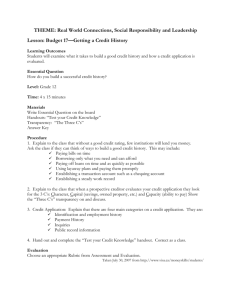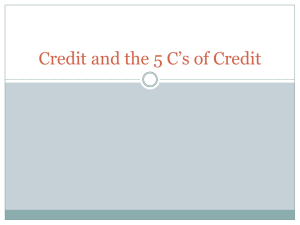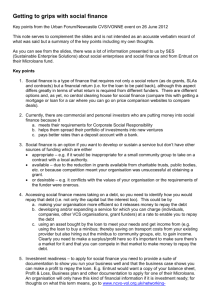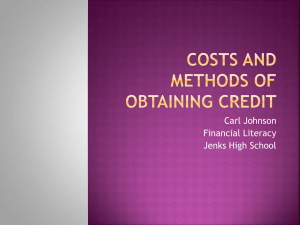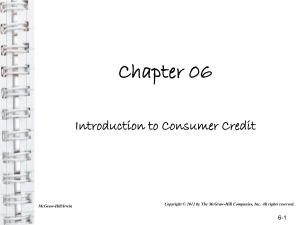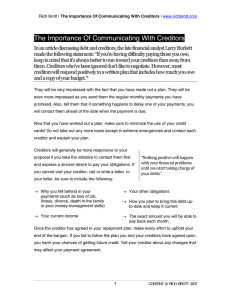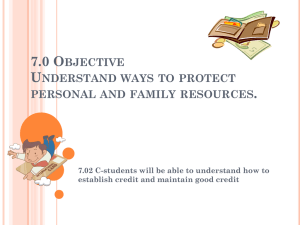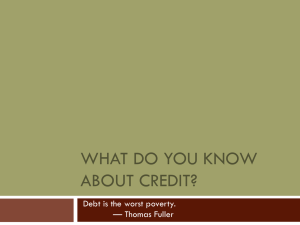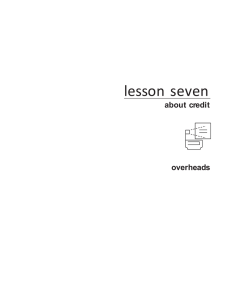UNIT FOUR
advertisement
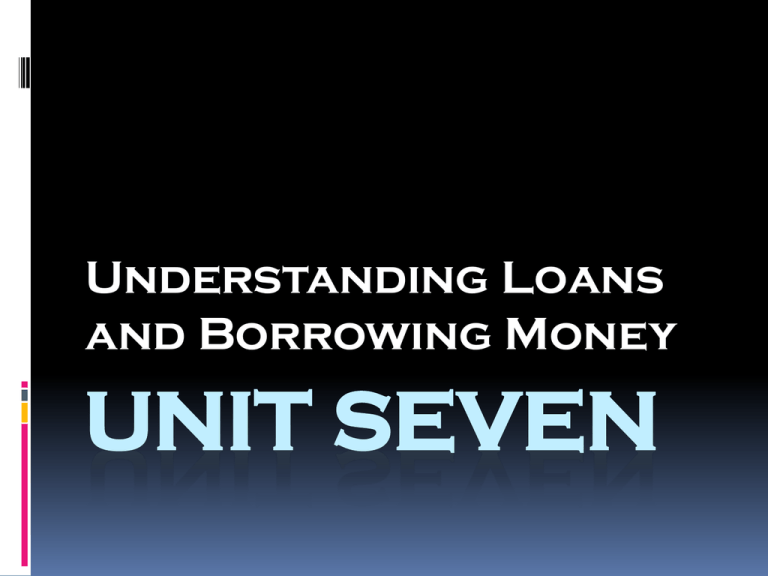
Understanding Loans and Borrowing Money UNIT SEVEN Development of Credit In the Past Credit Today The Vocabulary of Credit (1) borrower, (2) creditor, (3) Capital, (4) Collateral, (5) repossession, (6) balance due, (7) finance charge, (8) minimum payment, (9) late fee, (10) due date, (11) installment agreement and (12) secured loan. Advantages of Consumer Credit Expand your purchasing potential Raise your standard of living. Credit is also very convenient. Disadvantages of Consumer Credit Credit purchases may cost more than cash purchases The larger your balance and the longer you take to pay it off, the greater the finance charges Kind of Credit Open-Ended Credit Closed-End Credit Service Credit Source of Credit Retail Stores Credit Card Companies Banks and Credit Unions Finance Companies Pawnbrokers Private Lenders Other Sources of Consumer Credit Credit Records Your Credit File How Information is Gathered and Used Types of Information Stored Creditworthiness The five Cs of Credit: (1) Character: Will you repay the debt?, (2) Capacity: Can you repay the debt?, (3) Capital: Is the creditor fully protected if you fail to repay?, (4) Conditions: What general economic conditions can affect your repayment of debt?, (5) Collateral: What assets back up your promise to pay? Getting Started with Credit Begin with a Saving Account Open a Checking Account Open a Store Credit Account Get a Small Loan Apply for a Credit Card Credit Ratings Different bureaus use different rating systems, but a point system is common. Another rating system, rates consumers according to how reliably they pay back money borrowed or charged. Consumers may earn ratings such as excellent, good, fair, or poor. Credit Reports Sections of a credit report: (1) Summary of Information, (2) Public Record Information, (3) Credit Information, (4) Account Detail, (5) Requests for Credit History, (6) Personal Information. Credit laws Consumer Credit Protection Act Fair Credit Reporting Act Fair Credit Billing Act Equal Credit Opportunity Act Fair Debt Collection Practices Act Responsibilities of Consumer Credit Responsibilities to Yourself Responsibilities to Creditors Creditors' Responsibilities to You. Protecting Yourself From Credit Card Fraud Safeguarding Your Cards Protecting Your Cards Online EXTRA CREDIT ASSIGNMENT Define and explain: (1) Standard Loan Practices, (2) Predatory Lending Practices and (3) Legal debt Collection Practices [2 PARAGRAPHS ON EACH TOPIC] YOU MUST DO INTERNET RESEARCH AND PROVIDE YOUR SOURCES Avoiding Unnecessary Credit Cost To reduce your credit costs: (1)accept only the credit you need, (2) make more than the minimum payment each month, (3) Do not increase spending when income increases, (4) Keep no more than two credit cards, (5) pay cash for small purchases, (6) Understand the cost of credit, (7) Shop for loans, (8) Take advantage of rebate programs. Why Credit Cost Vary (1) Source of credit, (2) Amount financed and length of time, (3) Ability to repay debt, (4) Type of credit selected, (5) Collateral, (6) Prime rate, (7) Economic conditions, (8) The business's costs of providing credit. Computing the Cost of Credit Simple Interest Formula Annual Percentage Rate Formula Credit Card Billing Statements
